Why didn’t my hydrangea bloom? What can I plant that the deer won’t eat? How do I overwinter this shrub in a container? You’ll find answers to these and many more of the most commonly asked questions in this season’s edition of Ask the Expert. Let’s dig in!
Questions About Hydrangeas and Other Shrubs

Why didn’t my hydrangea bloom?
Why does my hydrangea only have a few blooms down near the ground?
Let’s group these two common hydrangea questions together since the cause is the same in both instances. Assuming your hydrangea is sited properly and is healthy, the reason you aren’t seeing flowers is most likely because something is either removing or damaging the flower buds. That “something” could be:
- Someone pruning the hydrangea at the wrong time of year.
- A deer or other critter eating the flower buds or flower heads.
- Very cold winter temperatures killing off the flower buds on old wood (last year’s stems).
- A late spring cold snap killing off buds just as they begin to unfurl.
Here are two more resources to go more in depth on this topic:
Why Didn’t My Hydrangea Bloom blog
Caring for Your Hydrangea page
Video: How and When to Trim Different Hydrangeas
How can I change my white hydrangea flowers to blue or pink?
Hydrangeas are interesting flowering shrubs in that the chemistry of the soil can sometimes influence the color of their flowers. You may know a friend or neighbor who turned their pink hydrangea flowers blue, for example. While this is possible for some types of hydrangeas, it’s not true of all hydrangeas. Here’s a quick primer covering the flower colors of the five main types of hydrangeas:
- Though many bigleaf hydrangeas (Hydrangea macrophylla) and mountain hydrangeas (Hydrangea serrata) can shift between pink and blue depending on soil chemistry, select cultivars cannot make this change at all. It is very rare for a bigleaf hydrangea cultivar to produce white flowers, but those that do cannot turn pink or blue regardless of soil chemistry.
- Smooth hydrangeas (Hydrangea arborescens) can produce either white or pink flowers depending on the cultivar, but these colors are inherent in the plant and are not influenced by soil chemistry. They all turn green or brown once they are spent depending on the growing conditions.
- Panicle hydrangeas (Hydrangea paniculata) all produce white flowers. Some have flowers that are pale green when they first open, but once fully open they are white. Most panicle hydrangeas can turn pink if their preferred growing conditions (primarily cooler night temperatures and ample moisture) are met. Some panicle hydrangeas don’t get much fall color. Once frost hits, they turn a parchment color.
- Oakleaf hydrangeas (Hydrangea quercifolia) also produce white flowers. For some cultivars, those white flowers can blush to pink later in the season before turning tan after frost.
If you’ve determined that your hydrangea has the potential to turn blue, this article will explain how to do so in depth: How Can I Turn My Hydrangeas Blue?
For additional information about pruning and feeding your hydrangeas, see our Caring for Your Hydrangea page.

Can I keep this shrub in a container over the winter?
Many types of dwarf shrubs can be grown in containers for multiple years if you choose the right ones for your climate. A simple rule of thumb is that to safely overwinter a shrub in a container, it should be at least two zones hardier than your zone. For example, if you live in zone 6, your shrub should be hardy at least to zone 4 to overwinter in the container without trouble.
We’ve written extensively on this topic, so be sure to check out these two helpful articles:
Can I overwinter this hardy plant in a container?
How to Grow Hydrangeas in Planters
Questions About Growing Perennials

What are the best long blooming perennials to put in the garden?
When your mother and grandmother were growing up, there really was no such thing as a “long blooming perennial” as we know it today. Each plant had its season; the tall bearded irises would grace the garden in June, the lilies would perfume the air in July, and so on.
It wasn’t until quite recently in the world of perennial breeding that the idea of a hardy plant blooming for several months in a row became possible. It is still true that most perennials still have a single season in which they bloom. However, when you are planting your perennial garden, you can plan it so something is always in bloom. We can show you how to do that here.
Keeping in mind that no perennial plant will deliver the same duration of flower power as annuals, here is a list of some long blooming perennials:
- Peruvian lily (Alstroemeria)
- Tickseed (Coreopsis)
- Coneflowers (Echinacea)
- Perennial geranium ‘Rozanne’
- Lavender (Lavandula)
- Russian sage (Perovskia)
- Tall garden phlox (Phlox paniculata)
- Rose mallow (Hibiscus)
Which perennials will rebloom if I cut them back?
Some varieties of perennials will bloom more than once per season if you remove the first round of spent flowers by cutting the plant back by about one-third its total height. A few examples include yarrow, catmint and false sunflowers. Find a more complete list of reblooming perennials in the article: What does “deadheading” mean and why should I do it?
Keep in mind that not all perennials will rebloom if you cut them back. That could happen if they aren’t a reblooming type, if your season isn’t long enough for them to gather enough energy to bloom again, or if they are stressed by drought, deer browsing or heavy shade. Still, removing the spent flowers can be beneficial for preventing reseeding and freeing up a plant’s energy to focus on growing stronger roots and a fresh flush of foliage.
Questions About Plant Selection
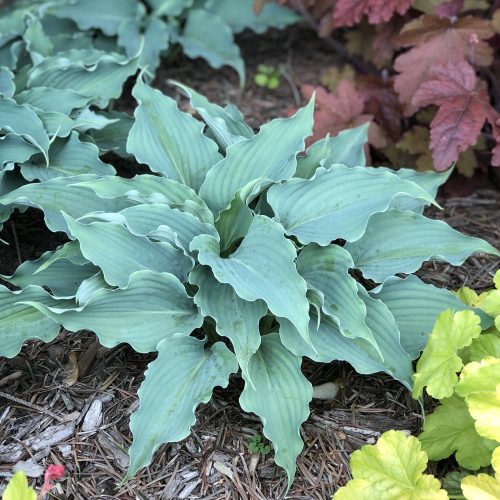
What are the best plants for clay soil?
Many people across the Midwest, South and other regions of the U.S. garden in clay soil, and proper plant selection can play an important role in such places. That’s because some plants aren’t naturally adapted to power through heavy, dense soil or can’t withstand the moisture extremes that come with clay soil. Oftentimes, it is necessary to use raised beds that allow a plant’s roots to grow above the heavier soil. Amending clay soil with compost, shredded bark and leaves over time can help to break up clay soil to allow it to drain more easily.
Hardy plants like hostas, dogwoods and daylilies can more easily adapt to growing in clay soils. Learn more about gardening in clay and find additional plant recommendations in this article: 10 Recommended Perennials and Shrubs for Clay Soil.
Can you give me some recommendations for plants for full shade?
First, let’s talk about the different kinds of exposure and what they mean so you understand how “full shade” is defined.
Exposure means how much sun or shade a plant receives and it is measured in hours. As the seasons change and the sun migrates to a more southern sky, the amount of sun or shade your plants receive changes. Also, since the morning sun is cooler than the hot afternoon sun, there is a difference in how these types of exposure are defined as you’ll see below.
Full Sun – Greater than 6 hours of sun, up to and including all-day sun
Part Sun – 4-6 hours of sun per day, with most of it being in the afternoon
Part Shade – 4-6 hours of sun per day, with most of it being in the morning
Full Shade – Less than 4 hours of sun per day
Notice that plants that receive a few hours of sun per day are still considered to be in full shade. Few ornamental plants grow where it is dark and there is no light at all. If you walked through a dense forest, you would notice that the forest floor isn’t full of flourishing plants. To grow ornamental plants, you do need some light to reach them. If that’s not possible, consider using that space for something else or simply cover the ground with shredded leaves or bark.
Learn much more about gardening in shade from our resources:
Ten Unique Plants for Shade Gardens
Five Ways to Decorate a Shaded Deck or Patio
Video: How to create a beautiful garden using shade plants
Video: Summer Planter for Shade
Video: Heart to Heart Caladiums
There are so many different challenges in my garden – deer, drought and shade to name a few. How do I know what’s going to work for me?
Have no fear! We’ve rounded up information about many of the most common gardening challenges into one helpful article. We’ll give you the link here so you can bookmark it for reference: Tough plants for Challenging Garden Conditions.
Questions About Soil
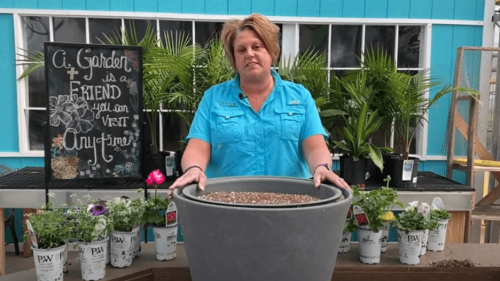
Can I reuse the soil in my pots from last year?
It’s not a good idea to reuse potting soil from year to year because:
- Its components break down into finer particles the older it gets, which reduces its ability to drain well.
- Nutrients leach out of the soil every time you water. By the end of the season, they are mostly gone, leaving little to feed your plants next year.
- Soilborne diseases can carry over from year to year, potentially infecting your new plants.
Read more about this topic here: What Kind of Soil Should I Use in my Containers?
Should I amend the soil when I am planting a new shrub or perennial, and should I fertilize it right away?
There are different schools of thought when it comes to amending the native soil when planting a new perennial or shrub. Some people recommend not using any soil amendments while others recommend adding a moderate amount of nutrient-rich material when planting.
One thing most horticultural professionals agree on is that it is never a good idea to dig a hole in the ground for your plant and backfill it only with non-native soil such as bagged top soil, compost, humus or manure. If you do so, you’re essentially creating a new pot for your plant in the ground. The plant’s roots will not easily grow out into the surrounding soil. Instead, they will circle back around and occupy only the non-native soil, eventually choking the plant out. Definitely avoid doing this when planting any new hardy plants in your garden.
Here’s a good compromise. If your soil is of decent composition, no amendments may be necessary when planting a new shrub or perennial. However, if you are gardening in solid sand (which contains very few nutrients) or very heavy clay, backfilling the hole with a mix of your native soil and no more than half non-native materials like compost or humus can be beneficial to the plant. Once you’ve planted a few new shrubs or perennials and observed how well they grow, you will get a better feel for whether or not you need to amend your soil when planting.
Fertilizing any newly planted perennials or shrubs is not recommended the first year you plant them. That’s because the potting soil they were growing in already contains slow release fertilizer and adding more can encourage top growth at a time when the plant should be focusing on establishing roots. However, you could use Espoma’s Bio-tone® Starter at the time of planting since it is not a true fertilizer but rather a product that helps plants establish roots more quickly.
Questions About Plant Pests and Diseases
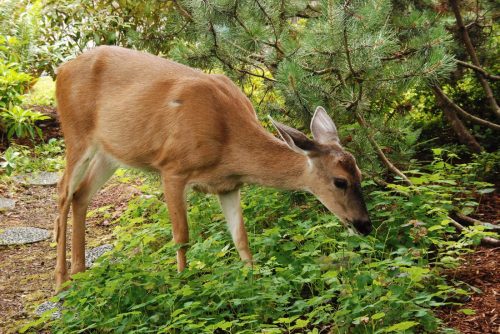
Deer and rabbits seem to eat everything I plant. How can I minimize the damage?
Seeing your favorite plants devoured by deer or rabbits can be very discouraging as a gardener, but there are some things you can do to mitigate the damage. If you need a guaranteed way to keep them away from your plants, you will need to put up a barrier of some kind to keep them out. But if erecting fencing isn’t practical for your situation, using animal repellents and choosing plants they prefer not to eat can help, too. We discuss all of these options in this article: Help! Rabbits and Deer Are Devouring My Plants. If deer are your main concern, don’t miss this article: Ten Plants Deer Won’t Eat.
How do I keep the slugs from making holes in all my hostas?
Using beer to attract and drown slugs may be the technique that first comes to mind, but there are several other ways to help control the slug population in your garden. And if you’re wondering about how to deal with petunia budworm, aphids, Japanese beetles, tomato hornworms and the pests that are making swiss cheese out of your hibiscus, you’ll find all of these things and more in this helpful article: How to Handle Slugs, Budworm and Other Common Garden Pests.
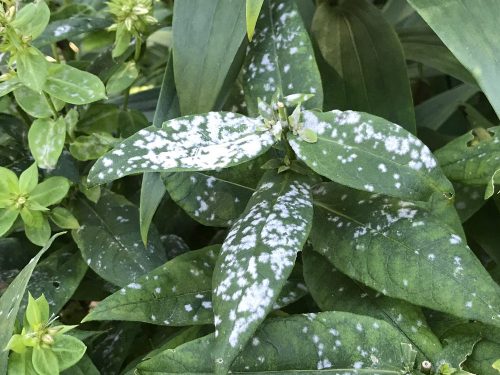
How do I control powdery mildew on my phlox, bee balm, peonies and other plants?
Powdery mildew is a type of fungus that appears as a white powdery substance on the surface of some plants’ leaves. It often appears initially as white speckles and then spreads to cover more of the leaves’ surface. Not all powdery mildew is the same. Certain types of this fungus affect specific types of plants, so if you try one type of fungicide and it doesn’t work, you may need to try a different kind before you find the one that works best for the specific plant you are treating.
The best way to control powdery mildew is to prevent it. Look for plants labeled as resistant to powdery mildew when you shop. Resistance is actually a genetic trait that is inherent in the plant. However, under the right conditions, even those that are most resistant can still get powdery mildew. Watering only in the morning and maintaining space between plants for air to flow can help to reduce the likelihood that powdery mildew will develop.
There are some factors out of your control which can set the stage for powdery mildew to move in. Warm, dry spells and warm, humid nights as well as nighttime rain followed by warm, muggy days all encourage powdery mildew to form. If these situations happen frequently in your climate, you can treat plants that are prone to powdery mildew with fungicides as a preventative measure. Be vigilant and continue to treat at the first signs of the fungus to help control its spread.
Mystery Ailments in the Garden
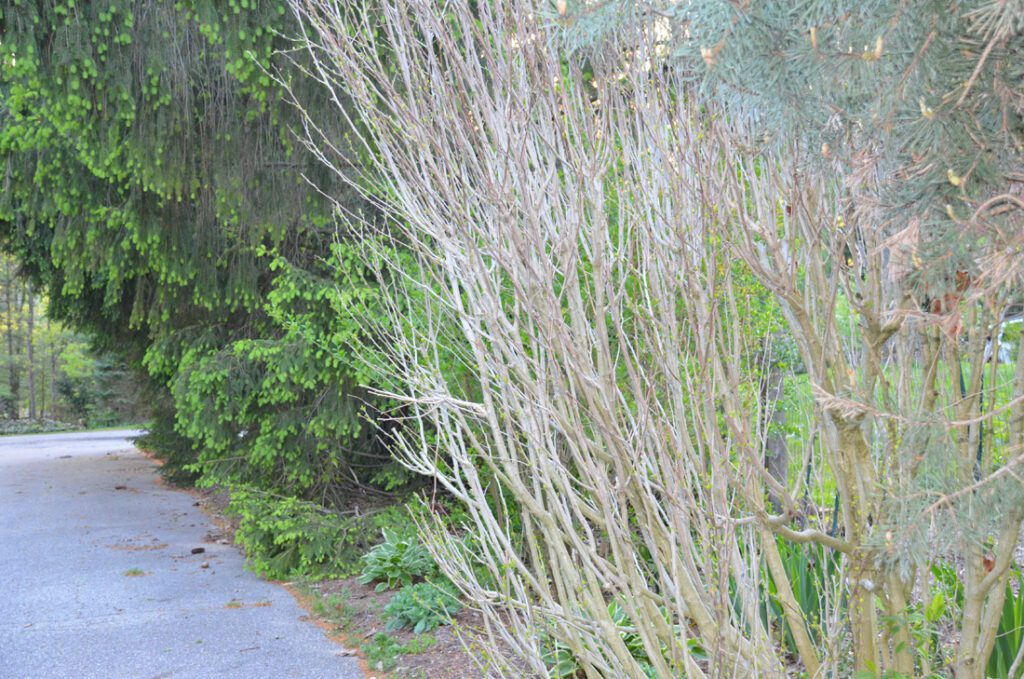
My _______ plant did something it’s never done before. Why did that happen?
Every year, customers challenge us to find the causes of mystery issues that pop up in their gardens. A plant that has bloomed reliably every year might suddenly quit blooming. One out of five of the same plants in a row might perform differently than the rest. A flower you’ve grown successfully every year in the same spot might be stunted one year.
As you become a keen observer of your garden and learn more about what plants need to survive and thrive, many of these mystery ailments will become understood. The answers will surface. Often, it’s a multitude of factors that converged to cause the issue.
Perhaps it was a late frost that killed off a plant’s spring flower buds and caused it not to bloom that year. Maybe rabbit populations are increasing in your area because their local predator populations have diminished, so they are damaging more of your plants. A disease might randomly infect a single plant in a group. A vole may eat the roots of a plant and its sudden death may take you by surprise. A plant that should grow well just won’t because of something it doesn’t like about your growing conditions.
Usually if you dig deep enough (Literally!), answers can be found, but not always. Sometimes things that happen in nature cannot be easily explained. Some garden ailments will remain a mystery.
Our website and YouTube channel contain a treasure trove of information about plants. Use the search function on our website to focus in on a keyword or try these links to delve deeper.
